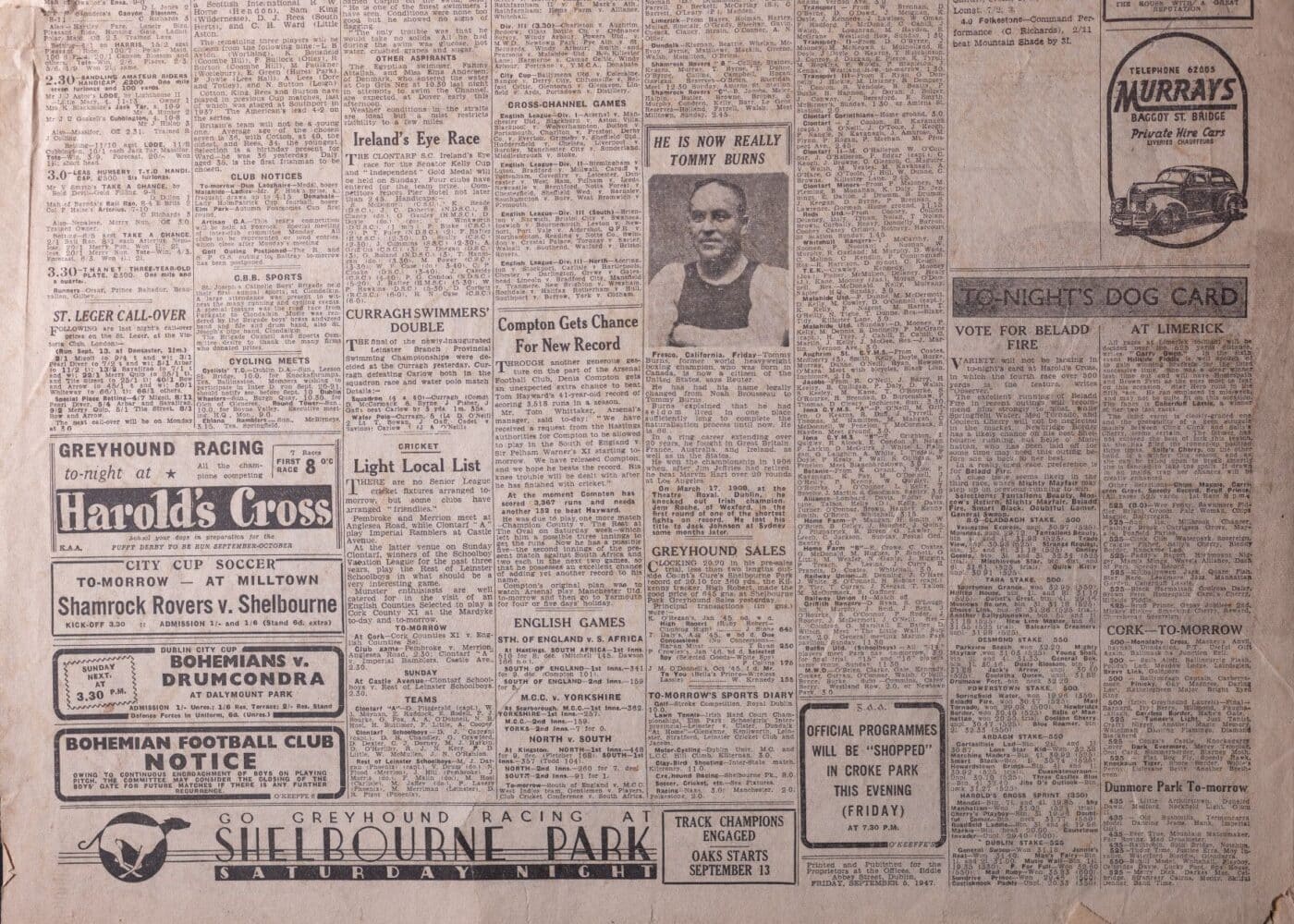Greyhound Racing Newspaper Section (1947)



Sports sections have long been a common feature of any newspaper, offering a glimpse into the popular pastimes of a given era. One copy of the Evening Herald from 1947 covers sporting activities that are still extremely popular today, such as football. But what really stands out is the large coverage given to greyhound racing, which was in its heyday in Ireland at this time.
Printed on Friday September 5th, the paper advertises a meeting at Harold’s Cross stadium in Dublin, with the first race beginning at eight o’clock that night. There is also mention of a puppy derby ‘to be run September-October’. The dog card for the races takes up a large chunk of the section. This lists each of the seven races taking place, their length in yards, the names of dogs competing, and the dogs’ previous time records. It seems that a Beladd Fire was the favoured competitor that night, with the Evening Herald writing that his ‘excellent running… in recent outings will recommend him strongly to most’.
Details are also given for races at Limerick, Cork, and Dunmore Park in Belfast. The bottom of the page also includes an advertisement for racing at another Dublin stadium, Shelbourne Park, the following night. This extensive coverage attests to the popularity of greyhound racing. But how did it become so popular in Ireland in the first place?
The origins of greyhound racing as a distinct sport can be traced to the early 1920s, but the activity itself is derived from the much older tradition of coursing. Practised for thousands of years, coursing involves the hunting of game by sighthounds, who hunt using sight rather than scent. It was present in Ireland around the sixteenth century as a pastime of the elite and became a formalised sport in the early twentieth century. The activity was transformed in 1919 when an American developed the mechanical hare, which could be chased by dogs in place of live game. Greyhound racing emerged from this invention, with the chase moving from open fields to enclosed stadiums. The first race on the island took place at Celtic Park in Belfast in 1927, followed by races at Shelbourne Park and Harold’s Cross. Viewed as an exciting new activity, these early meetings attracted great crowds. The stadiums’ use of electric lighting was likely part of the appeal, as this was uncommon for sporting events at the time. This innovation allowed races to take place later in the day, and the sport became a new kind of evening entertainment.
Greyhound racing has been closely associated with gambling since its very beginning, which added to its popular appeal. Gambling and sports had gone hand-in-hand for centuries, and dog racing was the latest activity through which one could try to win a profit. However, this association led to both moral concerns and legal interventions targeting greyhound racing and other sports. Although it was introduced before greyhound racing reached the country, the 1926 Betting Act applied to bets made for dog races. This saw the introduction of betting levies and a licensing scheme for bookmakers, allowing the government to gain revenue from the growing sports industry.
Greyhound racing quickly became an important part of this industry. The breeding and export of greyhounds was extremely profitable, and by 1947, more and more companies were established to take advantage of this. The next decade would see the transformation of the industry with the creation of Bord na gCon, a semi-state body intended to promote and regulate all aspects of the sport. Following this, races were increasingly sponsored by large corporations from the 1960s.
However, the popularity of greyhound racing would eventually begin to wane. A number of tracks have closed in recent years, including the one at Harold’s Cross. The sport has increasingly been subject to growing scrutiny, as concerns shift towards the welfare of race dogs. In response to this, the government introduced a Greyhound Racing Act in 2019. While attitudes have changed and the future of the sport is more uncertain, its significance to twentieth-century Irish cultural life is clearly shown within material from the era.
#OpentheArchives posts